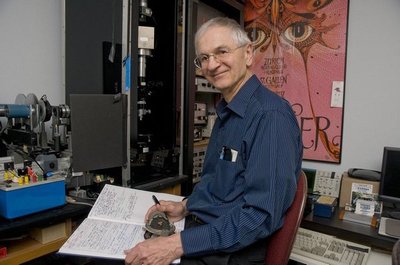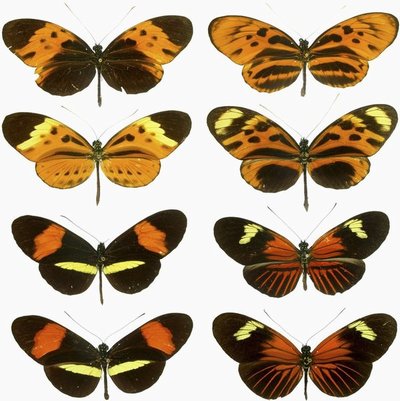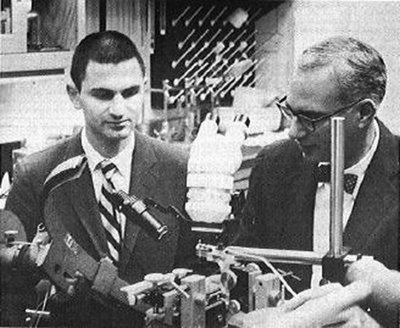January 28, 2010
Butterfly vision through the eyes of an engineer
Some people might spend their retirement relaxing at a beachside condo. Others might travel to exotic places, or tick items off their bucket list. Gary Bernard, on the other hand, goes eye to eye with butterflies in the laboratory he built into his Federal Way home.
After retiring from his full-time job at Boeing two years ago, Bernard, a UW affiliate professor of electrical engineering, has more time to focus on his research. Last week he co-authored a paper in the Proceedings of the National Academies of the Sciences that may shine light on how some butterflies seek out prospective mates.
For Bernard, it’s just the latest in what has already been a full and eventful career. After completing his undergraduate, Master’s and doctoral degrees in electrical engineering at the UW researching electromagnetic waves, he went to the Massachusetts Institute of Technology on a fellowship. Soon afterward he moved to Yale University to work with a physiologist on an unusual project: using electromagnetic waves to study insect vision. What began as a five-year stint ended up lasting 21 years, and he eventually held joint appointments in Yale’s departments of engineering and applied science and ophthalmology and visual science.
Over the years he has published scientific papers on bees, houseflies, dragonflies, spiders, beetles, butterflies and moths. One series of publications showed that spiders make webs that reflect ultraviolet wavelengths to attract prey. Another study explored the pointillistic, or dotted, iridescence of beetle shells.
In the late 1980s Bernard moved back to Seattle for a job at Boeing and brought his research equipment with him. Because it had been paid for with federal funds he could not keep it at a private company. He approached his alma mater and became an affiliate professor in the UW’s department of electrical engineering, which allowed him to store his equipment on campus and co-advise graduate students.
As an employee in Boeing’s commercial airplanes group Bernard looked at ways to process signals to detect wear and tear while machining parts. He also helped establish the Center for Auditory and Acoustic Research at the UW, a multi-university partnership focused on acoustic monitoring.
“He just loved working with the students and working with junior faculty,” said Les Atlas, a UW professor of electrical engineering and collaborator of Bernard’s. Over the years Bernard has co-advised twelve UW graduate students.
Yet all the while Bernard kept up his butterfly research as a hobby. Atlas remembers that at scientific meetings his colleague could be found wandering off with a butterfly net in hand.
In the 1990s Bernard was introduced to Adriana Briscoe, then a graduate student at Harvard studying butterfly evolution, and began their research collaboration. Briscoe is now an associate professor of ecology and evolutionary biology at the University of California, Irvine and the corresponding author on the new paper, the latest of 10 joint publications. Bernard does the measurements then sends the specimens to Briscoe’s lab for the genetic analysis.
Bernard’s basement is filled with butterfly paraphernalia — dried insects, pictures, postcards, towels, rugs and coasters all decorated with butterflies. The latest research may help answer a longstanding mystery of the butterfly dating scene.
Heliconius butterflies are famous for having many different species, up to a dozen of which may look identical to confuse predators.
“OK, they fool the predators, but how do they avoid fooling themselves?” said Bernard. “How do they recognize butterflies of the same species when they look so similar?”
According to the new results, Heliconius erato has evolved a second receptor for ultraviolet light.
“Color vision is always from a comparison of receptors that have different spectral sensitivities,” Bernard explained. Having two ultraviolet receptors then makes the butterfly sensitive to small variations in the UV range. What’s more, the UC Irvine researchers found ultraviolet blotches on Heliconius erato’s wings not found on other species. The ultraviolet spectrum could be a “private channel” that this species can use to communicate.
Bernard is a father of four and a grandfather of nine. When he and his wife finished their basement several years ago Bernard used the opportunity to design a space for his research equipment. The centerpiece is a Rube Goldberg-type contraption dotted with tape and tinfoil to keep out the light leaks, and powered by an ancient computer.
Having the device set up in his home makes it easier to do his research.
“It’s much more convenient than having it at the UW,” Bernard said. “These experiments take three days on a given butterfly, so I can get up in the middle of the night to change the settings and go right back to bed.”
Asked what his wife thinks about his home lab, he laughed and said, “No comment.”
Butterflies, Bernard discovered in the 1960s, have eyeshine, the property that makes a raccoon’s eyes shine in the glare of a car’s headlights. A reaction between incoming light and molecules in the eye causes wavelength shifts in eyeshine color. Bernard measures this carefully for each wavelength to learn exactly which ones the insect can see.
The experiments can be painstaking. In some instances he waits for eight hours in the dark, flashes bright orange light, then measures with dim flashes in different colors every half-hour to see how the eye responds. He takes advantage of visual molecules in the eye that take many hours to recover to learn how the eye functions. A second technique measures pupil contraction in the insects’ compound eyes to verify the results.
“Gary does really unusual work. He does physiology on living butterflies. It’s an extremely technically challenging, computationally challenging kind of experimental work,” Briscoe said.
As to whether the research partnership would continue, Briscoe said: “Oh yes, absolutely, we have many more exciting things in the pipeline.”
This study’s implications are still speculative, the authors caution, because they have not yet tested whether birds and other predators can also see the ultraviolet wing patterns. But there’s a follow-up paper in the works.
“It’s really cool for me, as an old guy, retired, to be still active and working with a young group that’s pushing the limits,” Bernard said.
More on the butterfly vision research is at http://visiongene.bio.uci.edu/.





